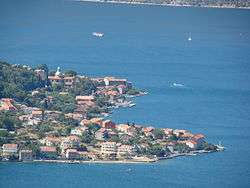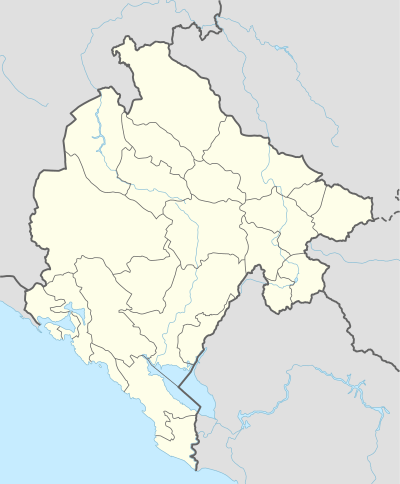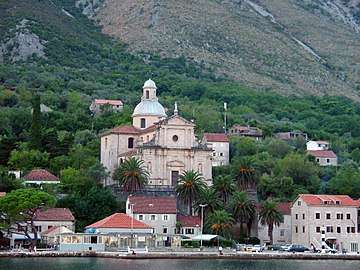Prčanj
Prčanj (pronounced [př̩tʃaɲ]; in Italian Perzagno) is a small town along the Bay of Kotor, Montenegro. According to the 2011 census, the town has a population of 1128 people.
Prčanj Прчањ | |
|---|---|
Town | |
 Prčanj Town Center | |
 Prčanj Location of Prčanj within Montenegro | |
| Coordinates: 42°27′27″N 18°44′32″E | |
| Country | |
| Population (2011)[1] | |
| • Total | 1,128 |
| Time zone | UTC+1 (CET) |
| • Summer (DST) | UTC+2 (CEST) |
It is located 3 miles (~5 km) west of Kotor, opposite Dobrota and between the settlements of Muo and Stoliv. All its history has been written at sea. It was one of the most important maritime centers on southern Adriatic.[2]
History
The village of Perzagno (now Prčanj) was closely related to the nearby port of Cattaro (or Kotor).
While under the rule of the Venetian Republic, Perzagno gained fame in a rather unusual way. By the end of the sixteenth century the administration noticed that sailors from here were able to sail to Venice in less time than the government ships. As a result, it was then decided that the port be given the responsibility for the permanent mail service of the Republic. This was further established by a decree of 1625 that praises the inhabitants of the port for their conscientious and effective handling of the State mail. The decree was of tremendous significance for the town, as it freed its citizens from manual labor, a mandatory form of state service at that time. The decree officially made Perzagno a naval town, and its duties to the State were henceforth of an exclusively maritime nature.
The importance of reliable mail service was of tremendous value to the Venetian Republic. Perzagno became the port from which the mail from Istanbul, which arrived over land through Montenegro, continued seaborne towards Venice. The town's ships were initially small in size, with crews of only nine men. The ships were ready to sail year round and would negotiate the 400 mile journey to Venice by oar and sail.
The town's privileges grew, and, in 1704, it was granted its own municipal district inside Albania Veneta. This was followed by the State's freeing the town of many tariffs. The lifting of tariffs provided an impetus for economic growth which further developed the town's naval character. Maritime trade flourished and its ships grew in size and number, so that by the end of the 18th century the port was hailed as home to over 30 tall-ships. The most prevalent trade goods were Montenegrin and Greek cheese, candles, salted sardines, and Dalmatian and Greek olive oil. The most frequent ports of call for the town's sailors were in the East Mediterranean or Levant, together with Ancona, Apulia, Venice, and Trieste.[3]
A significant setback for the port's maritime economy happened after the fall of the Venetian Republic (1797), which saw the arrival of the French under Napoleon and the resultant devastating British blockade of the Adriatic coast. The town was a part of the Napoleonic kingdom of Italy, but after Napoleon's defeat all the Bay of Kotor (Bocche di Cattaro) it was ceded to the Austrian Empire at the Congress of Vienna and became part of a province called the Kingdom of Dalmatia. This initiated a revival of the town's maritime economy which lasted until the end of the 19th century, after which its tall-ships could no longer compete with the rapid advances in steamship technology.
Architecture
Architecture in Prčanj bears witness to its prosperity in the 17th and 18th centuries. The town's waterfront consists of a long line of stone villas, unified by their beautiful facades and separated by gardens and olive orchards. The most impressive feat of architecture in Prčanj is the Nativity of the Blessed Virgin Mary church. It seems out of proportion to the number of inhabitants and took 120 years to build (1789–1909).[4]

It was designed by a Venetian architect Bernardino Maccaruzzi. The church has a monumental baroque facade with Corinthian and Doric columns and displays a collection of paintings and sculptures worthy of its size, including works by Piazzetta, Tiepolo, Balestra, Meštrović, and numerous other artists.[5][6]
Notable people
- Ivan Visin (1806–1868), sea captain who embarked on a trip around the world and circumnavigated the globe aboard his ship Splendido
- Jozo Gjurović (1827–1883), sea captain and the leader of national revival in Bay of Kotor
- Don Niko Luković (1887–1970), parish priest of Prčanj, writer and historian
References
- "Montenegrin 2011 census". Monstat. 2011.
- Kalezić, Danilo. "Kotor". Grafički Zavod Hrvatske, 1970, p. 15.
- Milošević, Miloš. "Kotor". Grafički Zavod Hrvatske, 1970, p. 69.
- Photo of the main Church of Perzagno
- Korać, Dr. Vojislav. "Kotor". Grafički Zavod Hrvatske, 1970, p. 80.
- Rellie, Annalisa. "Montenegro". The Globe Pequot Press Inc, 2005, p. 128.